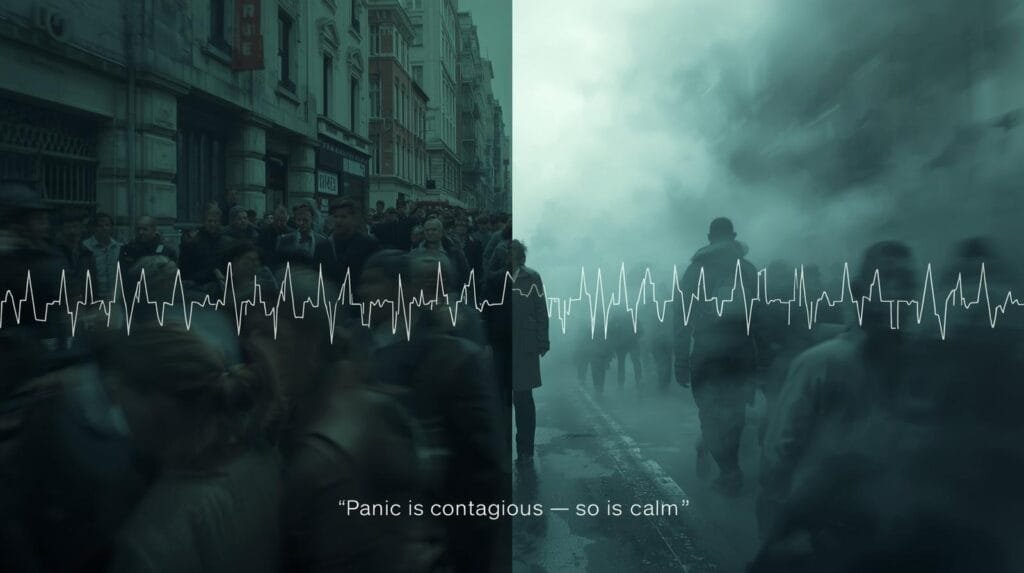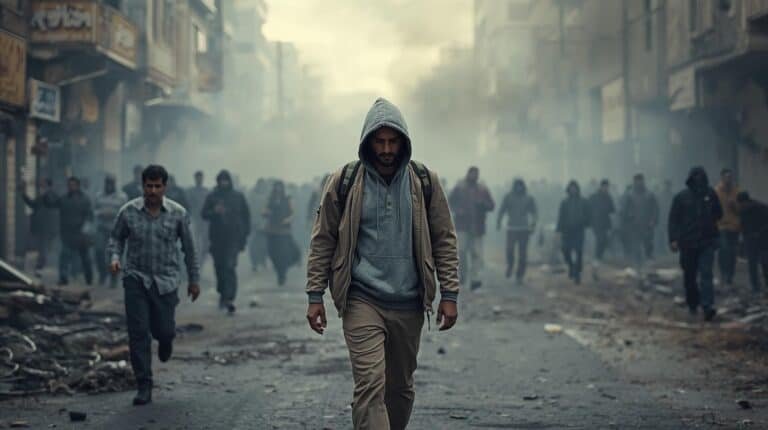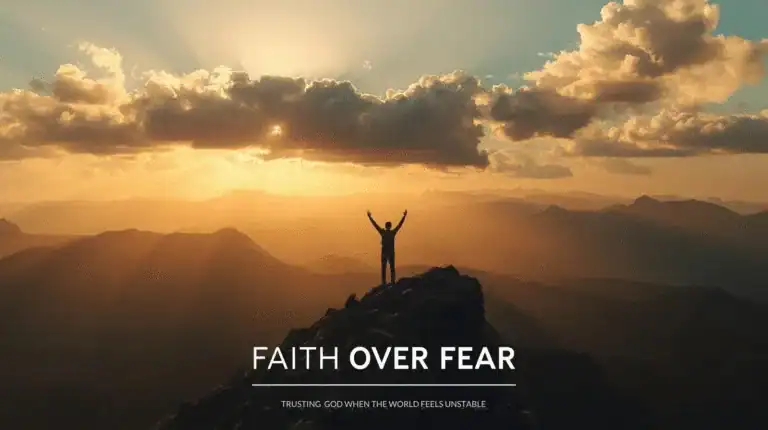
Stay Calm in a Crisis: The Calm Operator’s Guide to Keeping Your Cool When Everyone Else Panics
When chaos strikes, people respond in very different ways. Some sprint for the exits, overwhelmed by fear. Others freeze, unable to move or think clearly. Then there is the calm operator—the person who quietly navigates through the storm while everyone else seems to lose their minds.
Whether it’s a sudden power outage, a medical emergency, or any unexpected event that disrupts the normal flow of life, crises can happen suddenly and without warning, catching you off guard. In these moments, your greatest survival tool isn’t your gear or physical strength—it’s your ability to stay calm in a crisis, your mindset and faith. This skill separates the prepared from the panicked, the confident from the anxious, and those who see a crisis as a challenge that can be overcome with calmness from those who follow blindly.
What Does It Mean to Be a “Calm Operator”?
Being a calm operator doesn’t mean you’re emotionless or unaffected by stress. In fact, everyone experiences fear, anxiety, and uncertainty during critical moments. The key difference is that a calm operator doesn’t let these feelings take control.
Instead of reacting impulsively to strong emotions, they master their internal thermostat, regulating their response rather than being driven by it. It’s not about denying reality or suppressing feelings—it’s about discipline and control.
The military calls this ability “command presence,” while spiritual teachings describe it as peace that surpasses understanding. The Bible encourages us with these words: “Do not be anxious about anything, but in every situation, by prayer and petition, with thanksgiving, present your requests to God.” (Philippians 4:6-7). This isn’t just a comforting phrase; it’s a practical survival strategy. Faith, preparation, and mental resilience are intertwined tools that help you stay calm in a crisis and maintain control over your thoughts and actions.
The Psychology Behind Panic and Peace

When a crisis happens, your body’s natural stress response kicks in. Adrenaline and the stress hormone cortisol flood your system, which triggers an increased heart rate as part of the body’s fight-or-flight response. This physiological reaction evolved to protect us from immediate danger. However, in modern emergency scenarios, this response can hinder your ability to think clearly and make rational decisions.
During these moments, the brain’s higher functions—like logic and fine motor skills—can diminish rapidly. Instead, emotions take over, leading to panic and irrational behavior. Panic is contagious; it spreads quickly as one person’s fear triggers anxiety in others, creating a chain reaction that can escalate into chaos.
The calm operator interrupts this cycle. Rather than letting fear multiply problems, they channel the surge of energy into slowing down their breathing, moving deliberately, and focusing on clear thinking. When you recognize that your racing heart and rapid breathing are just your sympathetic nervous system activating, you can consciously engage your parasympathetic nervous system to restore balance and help you stay calm in a crisis.
Effective Communication in Crisis Situations
In the heat of a crisis, how you communicate can make all the difference between chaos and control. When stress hits, your body’s natural response—rapid breathing, racing thoughts, and a surge of adrenaline—can make it hard to think clearly or express yourself. That’s why it’s so important to pause and use deep breathing to reset your stress response before you speak.
Practicing mindfulness techniques, like meditation or simply focusing on your breath, can help you stay calm and focused, even when the pressure is on. In emergency scenarios, having a clear communication plan is essential. Make sure every team member knows their role, and check in regularly to share updates and dispel negative thoughts or rumors that can fuel anxiety.
Remember, effective communication isn’t just about talking—it’s about listening, staying informed, and responding thoughtfully. In a crisis, calm and effective communication is your best tool for managing risk and ensuring everyone’s well-being.
5 Practical Ways to Stay Calm When Everyone Else Loses It
1. Breathe Like It’s Your Job
One of the most effective ways to regain calm in a stressful situation is through your breath. When anxiety rises, breathing becomes rapid and shallow, signaling your brain that danger is near and intensifying the panic loop.
You can break this cycle with tactical breathing, also known as box breathing: inhale for four seconds, hold for four seconds, exhale for four seconds, and hold again for four seconds.
This technique isn’t just “zen” advice—it’s backed by neuroscience. Navy SEALs use box breathing to stay calm and focused before high-pressure operations. You can apply it in any emergency, whether your power goes out or you face a sudden crisis.
By practicing deep breathing, you activate your parasympathetic nervous system, which acts as your body’s natural “calm switch,” helping you stay calm in a crisis and maintain control. It’s one of the most powerful tools in your mental resilience toolkit.
2. Let Faith Lead, Not Fear
True calm often stems from a source beyond yourself. When you trust in something greater—whether that’s faith, spirituality, or a strong personal conviction—you shift your mindset from “I must fix this” to “I must stay faithful through this.” This perspective lightens the burden of control and reduces anxiety.
The Psalmist reminds us, “Be still, and know that I am God.” (Psalm 46:10). This call to stillness isn’t about physical inactivity but about cultivating peace amid the storm. The calm operator isn’t fearless; rather, they are faithful, drawing strength from their trust in the bigger picture.
When you ground yourself in faith, you’re not ignoring reality—you’re choosing to view it through a lens of hope and purpose. Faith provides the emotional and spiritual framework that allows you to stay calm in a crisis even when circumstances feel overwhelming.
3. Train Like You’ll Forget Everything
In a real crisis, adrenaline can cloud your mind and make it difficult to recall procedures. That’s why training is essential. You don’t rise to the occasion—you fall to the level of your preparation. Muscle memory and practiced responses beat panic every time.
Simple drills can make a huge difference: practice finding your flashlight in the dark without fumbling, navigate your home blindfolded, simulate a power outage and cook without electricity, or rehearse quiet evacuations at night. Each repetition teaches your brain that emergency scenarios don’t have to lead to chaos—they can be managed calmly and effectively.
For better results, consider following a structured crisis management process to prepare for and manage crises effectively. Organizations that conduct regular drills respond more effectively when real emergencies occur.
4. Stay Situationally Aware
Panic thrives in confusion and blindness. Staying calm requires situational awareness—constantly assessing your surroundings, noticing exits, listening for unusual sounds, and reading people’s body language. This doesn’t mean becoming paranoid; it means being present and alert.
The calm operator keeps their head on a swivel, not out of fear but out of curiosity and focus. By scanning for information rather than danger, they stay ahead of unfolding events and maintain control. This awareness helps you stay calm in a crisis because you already understand what’s happening around you, reducing surprises and uncertainty.
Develop your situational awareness through daily practice. When you enter a room, take a moment to observe: Where are the exits? What’s the general mood? Are there any potential hazards? These habits become automatic with practice and serve you well when emergencies strike.
5. Anchor Yourself Physically
Fear generates energy that needs an outlet. If your body is trembling or your heart races, grounding yourself physically can help. Plant your feet firmly on the ground, grip something solid, or speak a calming verse or prayer out loud. Physical grounding signals your brain that you are safe and in control.
You can create a “calm kit” with items that help you focus during stressful situations: a small multitool as a symbol of readiness, a prayer token to remind you of your faith, a stress ball for immediate relief, or a notepad and pencil for planning. These tangible reminders reinforce your ability to manage pressure and respond thoughtfully.
Support Systems: You’re Not Alone in the Storm
No one is meant to weather a crisis alone. Building a strong support system is essential for staying calm and managing stress, especially when emergencies strike. Whether it’s colleagues, family, or friends, having people you can talk to and lean on during critical moments can make all the difference.
Support systems aren’t just about emotional comfort—they can also provide practical help, from sharing responsibilities to offering a fresh perspective when you’re under pressure. Practicing self care, such as regular exercise, meditation, or simply taking a break to recharge, helps you stay focused and manage the stress hormone cortisol.
Remember, staying calm is easier when you know you have backup. By prioritizing self-care and nurturing your connections, you build resilience and the ability to respond effectively to any crisis.
Why Faith and Preparedness Go Hand in Hand

Faith without action is wishful thinking, and preparedness without faith can breed paranoia. The calm operator balances both. They stock supplies and plan for emergencies, but they also guard their heart with trust and perspective.
As Proverbs says, “The prudent see danger and take refuge, but the simple keep going and pay the penalty.” (Proverbs 22:3). Faith provides perspective and peace, while preparation offers practical options and confidence. Together, they form a powerful shield against panic. In a world that often sells fear because fear sells, real faith is the ultimate anti-panic protocol.
When others lose their cool, the calm operator’s quiet composure becomes contagious, spreading peace instead of panic throughout their team and community. This combination of spiritual grounding and practical readiness enables you to stay calm in a crisis regardless of what unexpected challenges arise.
Training Yourself to Stay Cool — Every Day, Not Just in Crisis
You don’t need a disaster to practice staying calm. The best training happens in everyday stressful situations: traffic jams, long lines, difficult conversations, or minor mishaps like spilled coffee. Each is a “micro-crisis,” a chance to rehearse calm and resilience.
Try these simple strategies: when frustration rises, slow your exhale; when someone is rude, respond with a smile instead of snapping; when things go wrong, pause for a few minutes before reacting. Each moment you choose calm over anxiety, you’re rewiring your brain to respond better under pressure.
The ability to stay calm in a crisis is not built overnight. It’s forged in the small daily decisions to choose peace over panic, to listen to faith instead of fear. Think of it as strength training for your nervous system. Every time you practice staying calm in a minor inconvenience, you’re building the mental muscle you’ll need when major challenges arise.
Leadership and Crisis Management: Guiding Others Through Chaos
When crisis hits, true leaders rise to the occasion—not by being fearless, but by staying calm, focused, and present for their team. Leadership in critical situations means managing your own strong emotions, so you can think clearly and make rational decisions under pressure. This is where mindfulness techniques, like deep breathing and meditation, become essential tools for maintaining composure and confidence.
A great leader communicates effectively, providing clear direction and honest updates, while also listening to the concerns and ideas of their team. Your ability to stay calm in a crisis sets the tone for everyone around you, helping to prevent panic and keep the team moving forward.
Leadership during a crisis isn’t about having all the answers—it’s about maintaining composure while you figure things out. People don’t need their leaders to be perfect; they need them to be present, calm, and decisive. When you model the ability to stay calm in a crisis, you give others permission to do the same, creating a cascade of composure that ripples through your entire organization or family.
The Calm Operator’s Creed
Being a calm operator isn’t about appearing tough or emotionless. It’s about becoming the person others can rely on when everything falls apart. When panic spreads, the calm operator breathes deeply, assesses the situation, and acts with purpose.
Remember this creed when chaos threatens to overwhelm you:
I will not be moved by chaos.
I will breathe, assess, and act with purpose.
I will prepare, pray, and stay present.
My calm is my power. My faith is my foundation.
This mindset keeps you steady when the world around you spins out of control. When the noise gets loud, the calm operator hears a whisper of peace.
Wrapping Up: Your Faith Is the Ultimate Force Multiplier
You can’t control what happens in the world, but you can control how you respond. Calmness is not a fixed personality trait; it’s a spiritual discipline developed through practice, prayer, and presence.
Learning how to stay calm in a crisis is one of the most valuable skills you can develop as a protector, leader, or simply as someone who wants to navigate life’s inevitable challenges with grace and effectiveness. It transforms you from someone who simply has resources into someone who knows how to lead when life suddenly changes course.
The calm operator doesn’t just survive crises—they help others survive them too. Their presence becomes a stabilizing force that prevents panic from spreading, bringing clarity to confusion, and providing hope when circumstances seem dire. The skills you develop in learning to stay calm in a crisis serve you far beyond emergency situations—they enhance every aspect of your life, from relationships to work to personal growth.
The next time the world spins out of control, remember this: the calm operator doesn’t panic because they have already practiced peace. They’ve done the preparation, built the relationships, cultivated the faith, and developed the skills needed to weather any storm. Faith, focus, and fortitude—that’s the way to navigate through crisis and emerge stronger on the other side.
Your journey to becoming a calm operator starts now, with the next small decision to choose peace over panic, preparation over procrastination, and faith over fear. And when crisis comes calling—not if, but when—you’ll be ready to stay calm in a crisis and guide yourself and others safely through to the other side.






